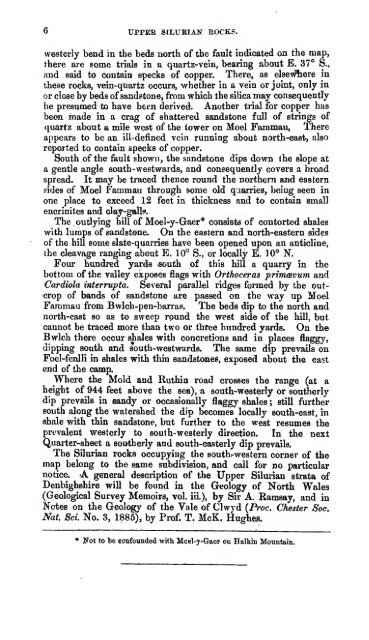The geology of the neighbourhoods of Flint, Mold, and Ruthin ...
The geology of the neighbourhoods of Flint, Mold, and Ruthin ...
The geology of the neighbourhoods of Flint, Mold, and Ruthin ...
You also want an ePaper? Increase the reach of your titles
YUMPU automatically turns print PDFs into web optimized ePapers that Google loves.
6 UPPER SII/UKTAN ROCKS.<br />
westerly bend in <strong>the</strong> beds north <strong>of</strong> <strong>the</strong> fault indicated on <strong>the</strong> map,<br />
<strong>the</strong>re are some trials in a quartz-vein, bearing about E. 37° S.,<br />
<strong>and</strong> said to contain specks <strong>of</strong> copper. <strong>The</strong>re, as elsewnere in<br />
<strong>the</strong>se rocks, vein-quartz occurs, "whe<strong>the</strong>r in a vein or joint, only in<br />
or close by beds <strong>of</strong> s<strong>and</strong>stone, from which <strong>the</strong> silica may consequently<br />
be presumed to have been derived. Ano<strong>the</strong>r trial for copper has<br />
been made in a crag <strong>of</strong> shattered s<strong>and</strong>stone full <strong>of</strong> strings <strong>of</strong><br />
quartz about a mile west <strong>of</strong> <strong>the</strong> tower on Moel Fammau. <strong>The</strong>re<br />
appears to be an ill-defined vein running about north-east, also<br />
reported to contain specks <strong>of</strong> copper.<br />
South <strong>of</strong> <strong>the</strong> fault shown, <strong>the</strong> s<strong>and</strong>stone dips down <strong>the</strong> slope at<br />
a gentle angle south-westwards, <strong>and</strong> consequently covers a broad<br />
spread. It may be traced <strong>the</strong>nce round <strong>the</strong> nor<strong>the</strong>rn <strong>and</strong> eastern<br />
sides <strong>of</strong> Moel Fammau through some old quarries, being seen in<br />
one place to exceed 12 feet in thickness <strong>and</strong> to contain small<br />
encrinites <strong>and</strong> clay-galls.<br />
<strong>The</strong> outlying hill <strong>of</strong> Moel-y-Gaer* consists <strong>of</strong> contorted shales<br />
with lumps <strong>of</strong> s<strong>and</strong>stone. On <strong>the</strong> eastern <strong>and</strong> north-eastern sides<br />
<strong>of</strong> <strong>the</strong> hill some slate-quarries have been opened upon an anticline,<br />
<strong>the</strong> cleavage ranging about E. 1 0° S., or locally E. 1 0° N.<br />
Four hundred yards south <strong>of</strong> this hill a quarry in <strong>the</strong><br />
bottom <strong>of</strong> <strong>the</strong> valley exposes flags with Orthoceras primavum <strong>and</strong><br />
Cardiola interrupta. Several parallel ridges formed by <strong>the</strong> outcrop<br />
<strong>of</strong> b<strong>and</strong>s <strong>of</strong> s<strong>and</strong>stone are passed on <strong>the</strong> way up Moel<br />
Fammau from Bwlch-pen-barras. <strong>The</strong> beds dip to <strong>the</strong> north <strong>and</strong><br />
north-east so as to sweep round <strong>the</strong> west side <strong>of</strong> <strong>the</strong> hill, but<br />
cannot be traced more than two or three hundred yards. On <strong>the</strong><br />
Bwlch <strong>the</strong>re occur shales with concretions <strong>and</strong> in places flaggy,<br />
dipping south <strong>and</strong> south-westwards. <strong>The</strong> same dip prevails on<br />
Foel-fenlli in shales with thin s<strong>and</strong>stones, exposed about <strong>the</strong> east<br />
end <strong>of</strong> <strong>the</strong> camp.<br />
Where <strong>the</strong> <strong>Mold</strong> <strong>and</strong> <strong>Ruthin</strong> road crosses <strong>the</strong> range (at a<br />
height <strong>of</strong> 944 feet above <strong>the</strong> sea), a south-westerly or sou<strong>the</strong>rly<br />
dip prevails in s<strong>and</strong>y or occasionally flaggy shales ; still fur<strong>the</strong>r<br />
south along <strong>the</strong> watershed <strong>the</strong> dip becomes locally south-east, in<br />
shale with thin s<strong>and</strong>stone, but fur<strong>the</strong>r to <strong>the</strong> west resumes <strong>the</strong><br />
prevalent westerly to south-westerly direction. In <strong>the</strong> next<br />
Quarter-sheet a sou<strong>the</strong>rly <strong>and</strong> south-easterly dip prevails.<br />
<strong>The</strong> Silurian rocks occupying <strong>the</strong> southwestern corner <strong>of</strong> <strong>the</strong><br />
map belong to <strong>the</strong> same subdivision, <strong>and</strong> call for no particular<br />
notice. -A general description <strong>of</strong> <strong>the</strong> Upper Silurian strata <strong>of</strong><br />
Denbighshire will be found in <strong>the</strong> Geology <strong>of</strong> North Wales<br />
(Geological Survey Memoirs, vol. iii.), by Sir A. Ramsay, <strong>and</strong> in<br />
Notes on <strong>the</strong> Geology <strong>of</strong> <strong>the</strong> Vale <strong>of</strong> Clwyd (Proc. Chester Soc.<br />
Nat. Sci. No. 3, 1885), by Pr<strong>of</strong>. T. McK. Hughes.<br />
JTot to be confounded with Moel-y-Gaer on Halkin Mountain.



